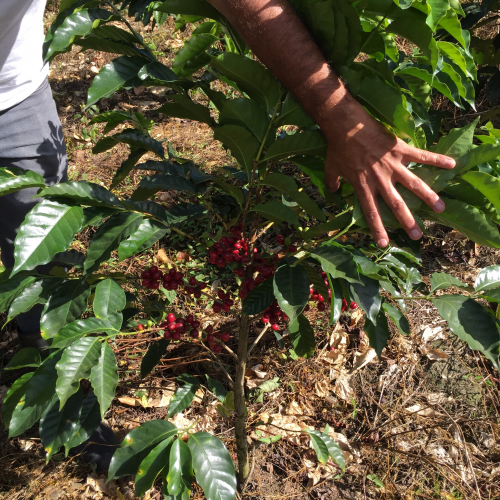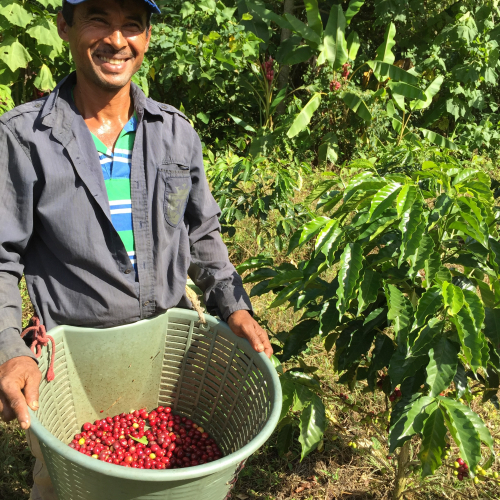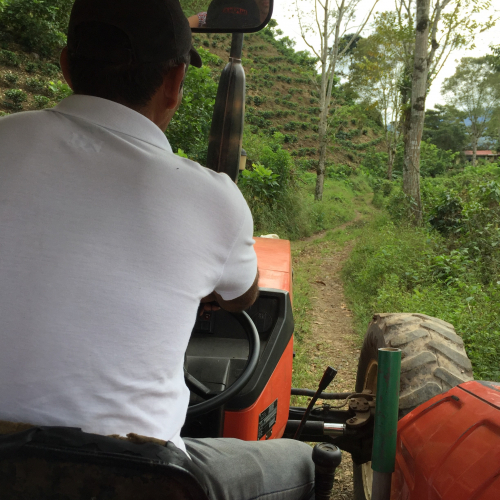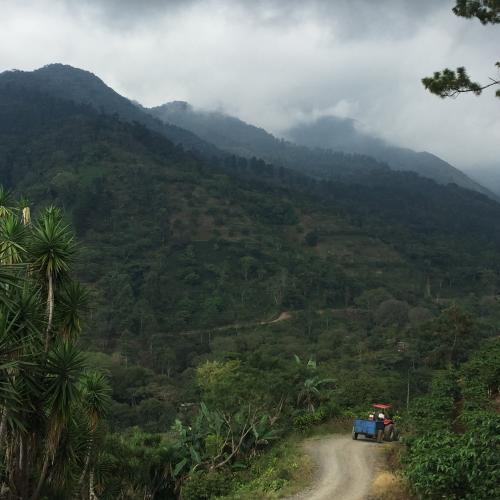Costa Rica
Did you know?
About
This very nice country is often compared to Switzerland. Not only for its mountains and nature, but also for its stability and safety. Costa Rica has a real coffee culture, a stable economy with no major political problems and within many ways an European way of living and working.
Costa Rica is located in Central America, with coastlines on the Caribbean Sea and Pacific Ocean. From the tropical coastal plains the land rises to rugged mountains and a temperate central plateau where most people live. The rainfall is heaviest on the east coast. Farming is the main activity and exports include bananas, pineapple, flowers, beef and of course coffee. There is a strong manufacturing sector, producing a range of goods from clothing (the main export) and electrical components to food products and cement, although these diverse range of industries, tourism is with agriculture, the main sector of activities.
Only Arabica
Quality has always been a high priority in Costa Rica, where only Arabica varieties are allowed to be grown under government mandate. Although coffee is only the country's third industry behind banana exports and tourism, it remains a highly emotional topic for Ticos, as coffee isa big part of local identity.
Coffee facts
Flowering Period
Main: from April until June
In the Central Highlands and the Pacific zone there are only two, at the most three, flowering periods with a fairly homogeneous ripening period. In the Atlantic zone, due to a greater quantity of rainfall, flowering occurs more frequently and thus extends the ripening period over a longer period of time.
Harvest Period
Main: from October until February
Costa Rica has one of the largest harvest periods in the world. The peak is between October and February, but some regions can have some punctual picking during almost all the year.Shipment Period
from March until September
Transit Days
|
Port of Shipment |
Imp. |
EU |
US |
|
Puerto Limon |
75% |
21 |
5 |
|
Puerto Caldera |
25% |
28 |
5 |
Destination countries
1. USA
2. Belgium
3. Switzerland, Finland, France, Italy, Germany
Whereas the old continent used to be the principal destination for Costa Rican coffee it is nowadays by far the USA. Imports of Costa Rican Coffee to the UK have been growing, placing it as the third largest destination after the US and Germany (where imports have fallen dramatically). The trade relationship with the UK is in fact 150 years old, inaugurated in 1845 when Captain William le Lacheur Lyon first shipped 4,000 bags of Costa Rican coffee to Liverpool and London.
Nice to know
Robusta production is forbidden by law. Almost 50 % of the total production is sold as "gourmet" coffee, mostly to the USA.
ICO Figures
Classifications
Varieties
Arabica Varieties include: Marsellesa, H1, H3, Tipica, Caturra, Catuai, Mundo Novo, Costa Rica 95, Hibrido Tico, Geisha, Villalobos, Villa Sarchi, Obatã, Bourbon, Venecia.
High cost of production.
Average wages of ± 3.50 USD/hour. Rigid rules towards child labour, ecology, and preservation of Natural Resoures. In the beginning of this century, Costa Rica recently reported its first-ever case of coffee borer beetle, and later, coffee trees in the country had suffered with coffee rust.
Coffee Regions
Main Regions in the past:
Atlantic or Pacific This classification originated from shipping limitations in a past era where regions, according to which side of the mountain ridge they were located on, shipped their coffee either from Puntarenas (Pacific) or Puerto Limon (Atlantic). Thus coffee initially shipped from the Pacific side all came from the higher regions of the country and were widely recognised as being of superior quality. Today, with transport limitations gone, this method of classification is no longer valid as coffees from all regions are mostly shipped via the Atlantic Ocean from Puerto Limon. Today, the emphasis is put on the growing region and/or the estate. The most famous for its qualities are: Tarrazu and Naranjo regions. But also San Ramon, Orosi and San Pedro are important
| SHB | Strictly hard bean | from 1200 -1650 m |
| HB | Hard bean | from 800 - 1100 m |
| USP | U.S. Preparation | Approximately 12 defects |
| EP | European Preparation | No more than 4 defects No major defects. |
Costa Rica SHB ep Naranjo
Costa Rica strictly hard bean, European preparation, from the region of Naranjo.
Picking
Selectively by hand
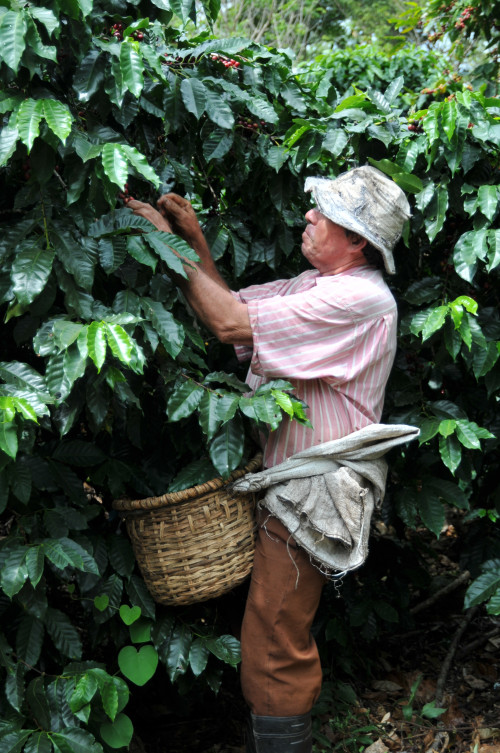
Picking is only done selectively by hand. The smaller planters deliver their daily yield to collecting stations "Recibidores", from where it is transported to the central "Beneficios". Bigger planters deliver their coffee directly to the "Beneficios" and some even process the coffee themselves. Due to the relatively high wages paid in Costa Rica, handpicking accounts for more than 25% (20.000 colones out of 85.000 paid per “fanega” - it’s equal to 1 bag of green coffee”) of the cost of coffee in this origin.
Washing
| Fully washed |
In the industrial process the coffee is fully washed. Honeys and naturals are microlot exclusive because the pulp would damage several parts of the mill!
It is important to note that in Costa Rica new, strict rules have been enforced to prevent pollution of the rivers during the washing process of coffee. The water used during this process must be re-used at least three times before being filtered, cleaned and released back into a river. Modern and environmental friendly mills don´t release the waste water in rivers but instead we spray them in grass fields to avoid polluting the water.
Fermentation
| From 2 to 15 hours depending on altitude |
Due to new laws concerning the preservation of the ecological system in Costa Rica, great care must be taken during the fermentation process to avoid pollution of the rivers, all while achieving a product of the highest quality. As fermentation time will vary and differ between various batches of coffee, it is important to fully control this process to avoid over- and underfermentation.
A coffee which was underfermented, will yield an earthy tasting cup. Coffee which was fermented too long will yield an overfermented cup (giving the coffee an almost chemical, sourish, unpleasant taste).
Drying
|
Sun and artificial drying |
Patio Drying in the sun : In the sundrying process, coffee is arranged in strips on drying grounds made of brick - sun dried coffee it’s exclusive for microlot coffees. Industrially processed coffees are always furnace dried (in drums, towers, etc) - almost never in concrete or clay whereas is continuously turned over until residual moisture attains a level of 11-12%.
Artificial Drying in Drums : The artificial drying process using large rotating air drums, is done in two stages. First a preliminary drying down to 35% residual moisture followed by the main drying to about 12% R.M. Although considerably faster drying is also widely recognised as reducing the quality of the coffee.
Sorting
|
Water / mechanical / electronic / by hand |
After sorting (water sorting is done at the beginning of the process) the coffee is often left to rest for a few weeks in large metal silos.
Coffee Environment
Marketing is in the hands of the private sector and coops but the government maintains supervision and control through ICAFE (Costa Rica Coffee Institute).
There is a 1.5% tax over the FOB value of all exports to finance INCAFE activities including marketing.
The sales of green coffee (exports) are handled by registered exporters and these can be producers,millers, cooperatives and foreign corporations. The export permit is granted by ICAFE and the govvernment as long as the applicant complies with all the requirements.
ICAFE has a board of directors where all the members of the coffee industry are represented and have the right to vote. The producers have the largest number of representatives in this board.
It is also important to mention that within the private sector a unique and transparent marketing system for exporting coffee is used.
Every contract between an exporter and a mill is public with regard to the price, as well as the volume of the coffee sold. Those are published regularly and are available to the general public. This way the exporters are always motivated to obtain the best possible prices and also attract additional business and coffee from the growers.
Sintercafé
Sintercafé began in 1987 over a simple cup of coffee... Costa Rican coffee, of course. Worried coffee farmers, millers, exporters and roasters were determined to organise an international dialogue capable of attracting hundreds of coffee buyers to Costa Rican territory, to a meeting in a coffee producing country where the productivity is one of the highest in the world. Minimal resources, yet burning intitiative, and unlimited desire for the well being of the Costa Rican Coffee market, established the "International Coffee Week". The goal was to improve the position of Costan Rican coffee in the world market, to promote modern harvesting methods and to industrialise the production of coffee. In all these phases, Costa Rica is a showcase. Acceptance of this seminar was and continues to be overwhelming. It has inspired organisers to continue this technically, socially and culturally balanced affair.
Some other important Marketing points :
- Costa Rica imports no coffee and local consumption is restricted to locally produced coffee.
- Annual competitions are organised between growers for the highest quality coffee. The outcome of this competition is that the top 10 coffees get to be in an exclusive auction known worldwide, roasters have paid up to $5.000/bag!!!
Also nice to know
The high level of local wages versus surrounding countries, combined with the rising value of farmland makes it more difficult for growers to expand or build new plantations.

